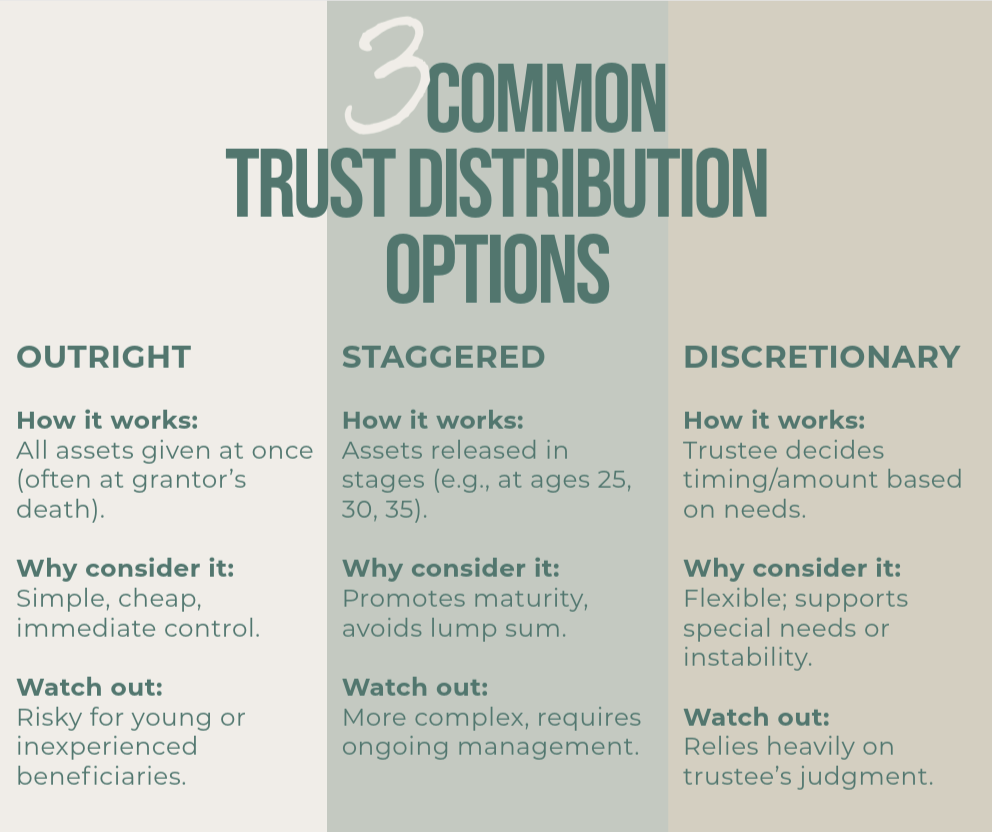Trust Distribution Options: Finding the Right Fit for Your Family
When creating a trust, one of the most important decisions you’ll make is how and when assets are distributed to your beneficiaries. This decision shapes not just the financial future of your loved ones but also the legacy you leave behind.
Below, we’ll walk through the main distribution options, why families choose them, and some important considerations.
Common Trust Distribution Options
1. Outright Distribution
How it works: The entire trust balance is distributed to the beneficiary(ies) at once, often when the grantor passes away.
Why consider it: Simple, inexpensive, and straightforward. Beneficiaries gain immediate access and control.
Things to think about: Outright distributions may not be ideal if the beneficiary is young, or financially inexperienced.
2. Staggered Distributions
How it works: The trust releases assets over time, such as a percentage at age 25, another at 30, and the remainder at 35.
Why consider it: Helps ensure beneficiaries don’t receive a large lump sum all at once, giving them time to mature and learn financial responsibility.
Things to think about: More complex to administer. It requires ongoing trust management for years.
3. Discretionary Distributions
How it works: The trustee has the power to decide when and how much to distribute, based on the beneficiary’s needs.
Why consider it: Offers flexibility, especially in situations where a beneficiary might have special needs, be struggling with addiction, or face financial instability.
Things to think about: Choosing the right trustee is critical since this arrangement gives them significant authority.
Why Families Choose Staggered or Controlled Distributions
There are many reasons to avoid an outright payout and instead structure distributions over time or with discretion, such as:
Age and maturity: Younger beneficiaries may need time to grow into financial responsibility.
Education and life stages: You might want to align distributions with milestones like finishing college or buying a first home.
Special needs: Ensures resources are preserved and available throughout the beneficiary’s life.
Substance abuse concerns: A discretionary trust allows the trustee to pause or limit distributions until the beneficiary is stable.
Why Successor Trustees and Staggered Distributions Don’t Always Mix
A key consideration is who will manage the trust. When distributions are staggered, the trustee’s role can last for many years. That can create challenges if the trustee is a family member or friend:
Longevity: The trustee may not want, or be able, to serve for decades.
Family conflict: If the trustee has discretion, their decisions could cause resentment among beneficiaries.
Burden of responsibility: Administering a trust over time requires recordkeeping, investment management, and sometimes uncomfortable judgment calls.
The Bottom Line: What Works Best for Your Family
There is no single “right” way to structure trust distributions. The best choice depends on:
Your beneficiaries’ ages, personalities, and needs
Your goals for how the trust should support them
The level of oversight and flexibility you want the trustee to have
For some families, outright distribution makes sense. For others, a carefully designed staggered or discretionary plan provides the right balance of support and protection.
Every family’s circumstances are different. To explore what type of trust distribution makes the most sense for your situation, reach out to Ballinger Legal to schedule a consultation. We’ll walk through your options and help you build a plan that fits your family’s needs today and for the future.

